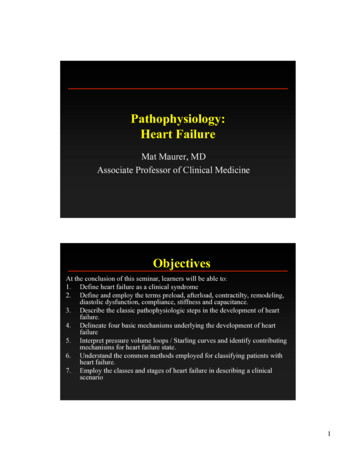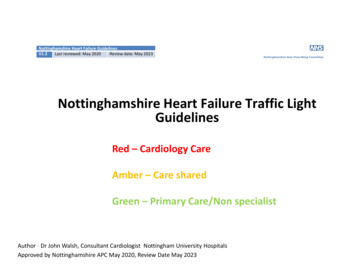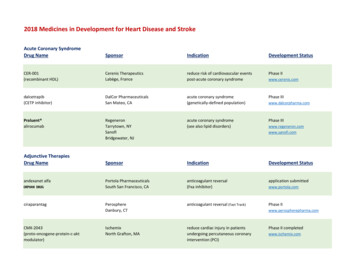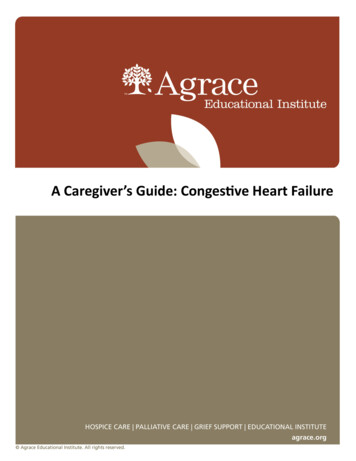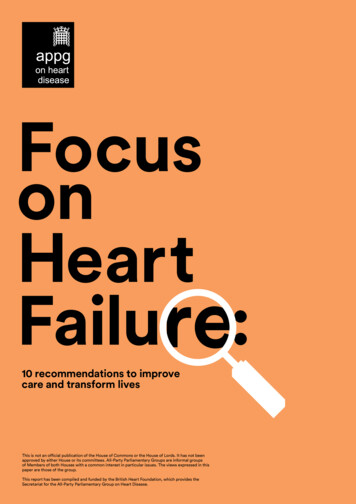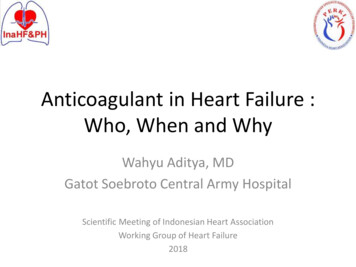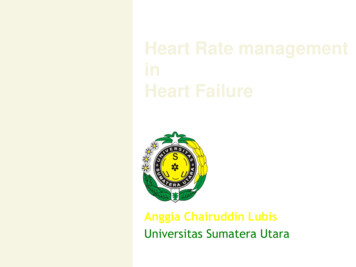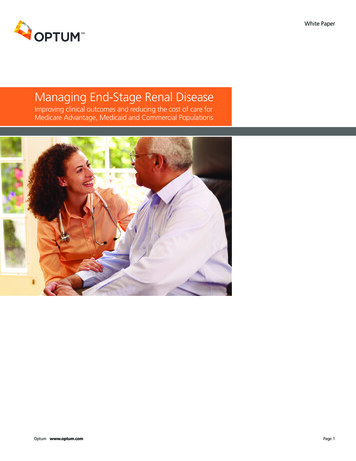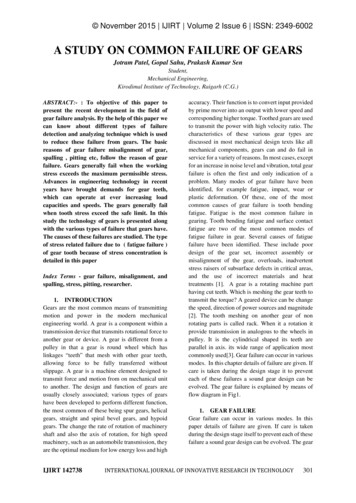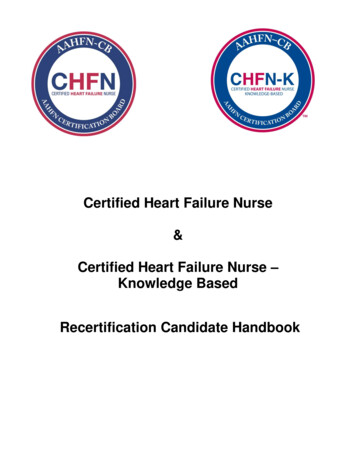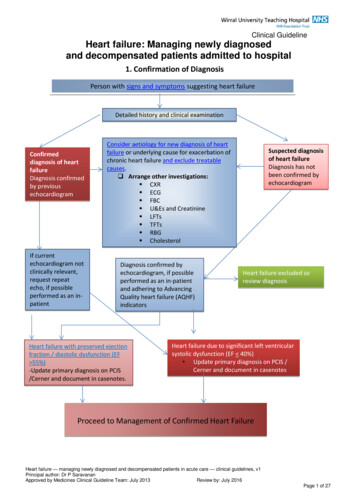
Transcription
Clinical GuidelineHeart failure: Managing newly diagnosedand decompensated patients admitted to hospital1. Confirmation of DiagnosisPerson with signs and symptoms suggesting heart failureDetailed history and clinical examinationConfirmeddiagnosis of heartfailureDiagnosis confirmedby previousechocardiogramIf currentechocardiogram notclinically relevant,request repeatecho, if possibleperformed as an inpatientConsider aetiology for new diagnosis of heartfailure or underlying cause for exacerbation ofchronic heart failure and exclude treatablecauses. Arrange other investigations: CXR ECG FBC U&Es and Creatinine LFTs TFTs RBG CholesterolDiagnosis confirmed byechocardiogram, if possibleperformed as an in-patientand adhering to AdvancingQuality heart failure (AQHF)indicatorsHeart failure with preserved ejectionfraction / diastolic dysfunction (EF 55%)-Update primary diagnosis on PCIS/Cerner and document in casenotes.Suspected diagnosisof heart failureDiagnosis has notbeen confirmed byechocardiogramHeart failure excluded soreview diagnosisHeart failure due to significant left ventricularsystolic dysfunction (EF 40%) Update primary diagnosis on PCIS /Cerner and document in casenotesProceed to Management of Confirmed Heart FailureHeart failure — managing newly diagnosed and decompensated patients in acute care — clinical guidelines, v1Principal author: Dr P SaravananApproved by Medicines Clinical Guideline Team: July 2013Review by: July 2016Page 1 of 27
2. Inpatient managementHeart failure with preservedejection fraction Refer to Heart FailureSpecialist Nurse forlifestyle advice: Stop smoking (smokinghistory, if smoker inlast 12 months verbaladvice, NRT or referralto smoking cessationservice and documentall) Diet, exercise,symptommanagement, dailyweights, medication,alcohol reduction /abstinence, annual fluvaccine x 1 Give heart failureinformation leaflet topatient or family/carerEnd of life care: Refer to guidelines forreferral to specialistpalliative care in endstage heart failure Complete DS 1500 If appropriate, initiateThe Liverpool Care ofthe Dying Pathway(LCP) Ensure ICD isdeactivatedHeart failure due to left ventricularsystolic dysfunction (EF 40%)Referral to heart failure specialist team.Arrange admission to appropriate ward/unitFluid balance:1. Fluid restriction 1-2 litres in 24hours2. Salt restricted diet3. Start loop diuretics e.g.furosemide 40mg od orincrease and titrate accordingto symptoms. If required slowintravenous injection initially50mg, increased by 20mgincrements (ie, to 70mg, 90mg,etc) not less than every 2 hours(doses depend upon clinicalstate and previous oral doses) In severe cases followingreview from heart failureteam, a thiazide (e.g.bendroflumethiazide) may beadded under close supervisionWard monitoring of heart failurepatients: Daily weights Strict fluid balance Sitting & standing BP Pulse Daily U&Es Monitor for improvement ordeterioration in heart failuresymptoms.Discharge planning: Ensure heart failure discharge letter is completed in a timelymanner detailing: correct primary diagnosis, echo result,medication commenced and/or discontinued, discharge bloodresults, discharge weight, required monitoring, and ward follow-uparrangements from acute Trust. Refer to heart failure specialist nurse service for follow-up For more information see Heart Failure Website - Heart failure NHS ChoicesDrug management:1. Start ACE inhibitor (ACEI) and titrateupwards.orIf ACEI not tolerated, considerangiotensin-receptor blocker inNYHA Class I-IV.2. Add beta blockers, when heartfailure stable, and titrate upwardsin NYHA Class I – IV. NB: if ACE I,ARB or beta blocker is contraindicated, document reason incasenotes.3. Add spironolactone 12.5 – 25mg od,up to 50mg od in NYHA Class III-IV.Close monitoring of U&Es &creatinine required. NB eplerenonecan be used as second line only ifpatient has painful gynaecomastia(unlicensed)4. Consider ivabradine in line withNICE TA 237.5. Consider low dose digoxin if in sinusrhythm.6. If remains symptomatic andintolerant to spironolactone,consider addition of candesartan toACE I under specialist supervision.7. Consider hydralazine and nitratecombination in African / Caribbeana)1.2.a)if still symptomatic on optimaltolerated drug therapy refer toCardiologist for consideration ofbiventricular pacemaker/ cardiacresynchronisation therapy(CRTP/CRTD) provided:EF 35%QRS 120 msconsider referral for assist devicesand transplantHeart failure — managing newly diagnosed and decompensated patients in acute care — clinical guidelines, v1Principal author: Dr P SaravananApproved by Medicines Clinical Guideline Team: July 2013Review by: July 2016Page 2 of 27
Signs and symptoms suggesting heart failure(back to top)Signs:Tachycardia, Gallop rhythm, crackles, raised jugular venous pressureThe main clinical signs of heart failure are due to: Cardiomegaly — ie, displaced apex beat, third heart sound Congestion — ie, oedema, jugular venous distension, pulmonary crackles Activation of the sympathetic nervous system — tachycardiaSymptoms:Dyspnoea, paroxysmal nocturnal dyspnoea (PND), fatigue, oedemaThe classic symptoms of heart failure are dyspnoea and fatigue. However, orthopnoea is more specificthan exertional dyspnoea when diagnosing heart failure, although its low sensitivity means it has littlepredictive value. PND has a greater sensitivity and predictive value.Aetiology(back to top)Ischaemic heart disease, dilated cardiomyopathy, primary valvular disease, hypertension, cardiacarrhythmias, viral infections, toxic substances (alcohol/certain medicines), anaemia, hyperthyroidism,pregnancy, congenital heart diseaseOccasionally no cause of heart failure can be found (ie, idiopathic)Treatable causes and aggravating factors(back to top) AnaemiaHyperthyroidismNon-compliance with medicationOther medicines — non-steroidal anti-inflammatory drugs, corticosteroids, diltiazem, verapamil,alcoholFast AFInfectionUncontrolled blood pressureImpaired renal functionHeart failure — managing newly diagnosed and decompensated patients in acute care — clinical guidelines, v1Principal author: Dr P SaravananApproved by Medicines Clinical Guideline Team: July 2013Review by: July 2016Page 3 of 27
Heart failure with preserved LV systolic function — diagnosis and management(back to top)Patients with: Clinical symptoms and signs of heart failure Supporting laboratory tests (eg, chest X-ray showing pulmonary oedema) A typical clinical response to treatment with diureticsand Echocardiography showing ejection fraction 50%can be classed as having HF with preserved LV systolic function.It would be useful to ensure that patients have at least one of the following in echocardiography, eventhough presence of these criteria is not imperative to make the diagnosis:1) Left atrium dilatation2) Evidence of left ventricle hypertrophy3) E/A ratio* more than 1 (trans-mitral doppler)4) IVRT ** 110msec or 60Msec (restrictive filling)*E early passive filling of the left ventricle, A late left ventricle filling due to atrial contraction. In normalcompliant ventricles, early filling should contribute to nearly 80% of the filling, which reverses when theventricles do not relax well (diastolic dysfunction).** IVRT (iso-volumetric relaxation time) is the time interval between closure of the aortic valve andopening of the mitral valve. In a compliant ventricle, this is short. It is prolonged if the left ventricle doesnot relax well (diastolic dysfunction). It can be very short in some conditions with a very restrictive fillingpattern such as infiltrative cardiomyopathiesTreatmentThere are no large scale clinical trials to confirm efficacy of most medicationsThe mainstay of therapy is diuretics.Heart failure — managing newly diagnosed and decompensated patients in acute care — clinical guidelines, v1Principal author: Dr P SaravananApproved by Medicines Clinical Guideline Team: July 2013Review by: July 2016Page 4 of 27
Admission to cardiology ward(back to top)The following patients should be admitted to a cardiology ward:A) New diagnosis of heart failure1) All new admissions with clinical features of heart failure with current echo showing ejectionfraction 40%2) Anyone with clinical features as above but an ejection fraction 40% and any of the following:Pulmonary oedemaShown on chest X-rayBilateral pleural effusionsEvidence of LVH by voltage criteriaEvidence of ischaemic heart disease or a previous myocardial infarctionShown on ECG— ie, Q waves in 2 contiguous leads, persistent deep T-waveinversion and dynamic ST-T changes with or without chest pain Evidence of significant valve disease (at least moderate)Shown on Evidence of significant left ventricular hypertrophyechocardiography Evidence of estimated PAP 45 mmHg 3) Anyone deemed by a cardiologist to have a new diagnosis of heart failure with preserved LVfunctionB) Patients previously known to have heart failureIf current admission relates to decompensation of heart failure as evidenced by any of thefollowing Respiratory distress (respiratory rate 40 breaths per minute) or pulmonary oedema (determinedby radiograph) Hypoxia (oxygen saturation 90%) Anasarca or significant oedema ( 2) Syncope or hypotension (systolic blood pressure 80 mm Hg) Evidence of ischaemia (chest pain with ECG changes) Significant recent reduction in exercise toleranceIt is useful to keep in mind that the following are the most common causes of heart failure: Ischaemic heart disease: 40% Dilated cardiomyopathy: 32% Valvular heart disease: 12% Hypertension: 11%Referral for device therapy in heart failure(back to top)Patients can be considered for cardiac resynchronisation therapy (eg, pacemaker or defibrillator) if theyhave a confirmed diagnosis of heart failure — either due to ischaemic or non-ischaemic aetiology withany of the following:Heart failure — managing newly diagnosed and decompensated patients in acute care — clinical guidelines, v1Principal author: Dr P SaravananApproved by Medicines Clinical Guideline Team: July 2013Review by: July 2016Page 5 of 27
A) NYHA class III or IV symptoms — left ventricular ejection fraction 35%, QRS duration 120ms in Sinus Rhythm (if the patient is in AF please, see C) and on optimal (maximal tolerateddoses of) heart failure medicinesB) NYHA class II symptoms — left ventricular ejection fraction 35%, QRS duration 150ms inSinus Rhythm and on optimal (maximal tolerated doses of) heart failure medicines.C) NYHA class III or IV symptoms — left ventricular ejection fraction 35%, QRS duration 130ms in AF with a slow ventricular rate needing a pacemaker or where AV node ablation iscontemplated as a rate control strategy and they are already on optimal (maximal tolerated dosesof) heart failure medicines.D) NYHA class III or IV symptoms — left ventricular ejection fraction 35% and in need of apacemaker for profound symptomatic bradycardia, where it is expected that they will use theirpacemaker more than 50% of the time.Referrals should be made to a device specialist — currently Dr.P.Saravanan, consultantcardiologist.Referral for cardiac transplant(back to top)Patients can be considered for cardiac transplant if they have one or more of the following (usually theywill be aged less than 65 years): Two or more admissions for treatment of decompensated heart failure within the last 12 months. Persistent clinical evidence of overt heart failure after optimised medical treatment Echocardiographic evidence of right ventricular dysfunction or increasing pulmonary arterypressure on optimal treatment (aim to refer before the pulmonary arterial systolic pressureexceeds 50mmHg). Deteriorating renal function attributable to heart failure or inability to tolerate diuretic dosagessufficient to clear congestion without change in renal function (aim to refer before creatinineclearance falls below 50ml/min or the estimated glomerular filtration rate [eGFR] falls below40ml/min/1.73 m2). Significant episodes of ventricular arrhythmia despite full drug and electrophysiology/devicetreatment.Heart failure — managing newly diagnosed and decompensated patients in acute care — clinical guidelines, v1Principal author: Dr P SaravananApproved by Medicines Clinical Guideline Team: July 2013Review by: July 2016Page 6 of 27
ACE inhibitors: Initiation and titration in adults with left ventricular systolicdysfunction(back to top)Evidence from clinical trials suggest that patients with, or at risk of developing heart failure showan improvement in symptoms and a reduction in morbidity and mortality when treated with anACE inhibitor (ACEI). Therefore, all patients diagnosed with heart failure due to left ventricularsystolic dysfunction should be considered for an ACEI.Indication: Confirmed LVSD EF 40% and no contraindication to ACE Inhibitor.Table 1. Contraindications and cautions for prescribing ACEI in LVSD Contra-indicationsBilateral renal artery stenosis Aortic or mitral valve stenosis oroutflow obstruction Known hypersensitivity to ACEI orexcipients or to any other ACEI.History to angioedema of any causePregnancy / risk of pregnancy Cautions Hypotension (systolic blood pressure (BP) 90mmHg Patients with a documented intolerance ofACEI due to symptomatic hypotension –consider re-challenging with a long actingACEI. Patients on high dose diuretics (i.e.furosemide 80mg daily) Breast feeding Moderate to severe renal impairment (i.e.creatinine 150μmol/L or eGFR 60ml ? min /21.73m ) Baseline potassium 5.5mmol/L Baseline potassium 5 to 5.5mmolConsider referral prior to initiation Creatinine 200micromol/L Urea 12mmol/L Sodium 130mmol/L Systolic BP 100mmHg Diuretic dose 80mg furosemide daily or bumetanide 2mg daily Known or suspected renal artery stenosis (e.g. peripheral vascular disease Frail elderly1. 2.Initiation and monitoringCheck baseline blood chemistry. (e.g. serum creatinine, urea, potassium, sodium and creatinineclearance) and blood pressure (BP)Discontinue potassium supplements/potassium sparing diuretics and review need for concomitantnephrotoxic drugs e.g. NSAIDsReview dose of diuretic therapy.Start with the lowest recommended dose of ACEI and titrate as suggested below. Aim for the targetdose, failing that, the maximum tolerated dose. Some ACEI is better than no ACEI.Dose TitrationHeart failure — managing newly diagnosed and decompensated patients in acute care — clinical guidelines, v1Principal author: Dr P SaravananApproved by Medicines Clinical Guideline Team: July 2013Review by: July 2016Page 7 of 27
BP and blood chemistry (e.g. serum creatinine, urea, potassium, sodium and creatinine clearance)should be checked within a week of initiation and within two weeks of each change of dose.Recheck at 1, 3, and 6 months after achieving maintenance dose, then 4 monthly thereafter. Reducedose/stop according to “worsening renal function” and “symptomatic hypotension” in “problemsolving” below.ACEI dose can be doubled at no less than 2 weekly intervals in the community. More rapid titrationmay be carried out in patients in hospital with close monitoring, tolerability permitting. Smallerincrements may be more clinically suitable for certain patients.Licensed ACEIStarting Dose (mg)Target Dose (mg)Ramipril1.25mg once daily5mg twice daily or 10mg once dailyLisinopril2.5mg-5mg once daily30-35mg once dailyRamipril and lisinopril are the Trusts ACEI of choice however some patients will require titration ofexisting therapy.3. What to do if the following problems occur:1. Angioedema Rare but life threatening. Discontinue therapy and seek immediate advice from accident andemergency.2. Worsening renal functionAn increase in urea, creatinine and K is to be expected after initiation/titration of ACEI. If the increase issmall and asymptomatic, no action is necessary. Please see the table below for recommended actions.Blood ChemistryActionCreatinine up to 50%above baseline or to No action required. Repeat blood chemistry (urea, creatinine and265µmol/L (whichever is potassium) within 2-4 weeks.smaller).OR K to 5.5 mmol/LCreatinine 50% but a) 100% above baseline orbetween 265µmol/L and310µmol/Lb)(whichever is smaller).OR K to 5.5 - 5.9mmol/LReview required- considerStopping concomitant nephrotoxic drugs e.g. NSAID’s, non-essentialvasodilators (e.g. calcium antagonists, nitrates) and if no signs of fluidretention, reduce the dose of diuretic.Review causes of high potassium. Stop other agents that causehyperkalaemia e.g. potassium sparing diuretics.If despite adjusting medication the creatinine and K remain higher thanabove the dose of ACEI should be halved and the blood chemistry rechecked in 5-7days. If the response to this is not satisfactory, seekspecialist advice.Blood chemistry should be monitored closely until K and Creatinineconcentrations are stableCreatinine by 100% Discontinue ACEI and discuss with cardiologist*(from baseline) or toabove 310µmol/L.OR K 6mmol/l* Note: it is very rarely necessary to stop an ACEI and clinical deterioration is likely if treatment is withdrawn; ideally,specialist advice should be sought before treatment discontinuation.Heart failure — managing newly diagnosed and decompensated patients in acute care — clinical guidelines, v1Principal author: Dr P SaravananApproved by Medicines Clinical Guideline Team: July 2013Review by: July 2016Page 8 of 27
3. Asymptomatic low blood pressure Does not usually warrant a change in therapy4. Symptomatic low blood pressure Consider dehydration and address as appropriate Review diuretic dose with a view to decreasing dose if patient free of symptoms suggestive of fluidretention. If dizziness and light-headedness and/or confusion occur, consider stopping nitrates, calciumchannel blockers and other vasodilators first, then consider reducing dose of beta-blocker Monitor closely and allow longer intervals between dose titrations. Consider reduction of ACEI doseto the previous tolerated dose. Seek specialist advice if measures do not resolve symptomatic hypotension5. Persistent dry cough Review aetiology of cough e.g. due to smoking, worsening heart failure/pulmonary oedema,respiratory disease or ACEI therapy. Review cough tolerability vs benefits of an ACEI. Some patients may tolerate re-institution of theACEI after a drug free period (ESC)Rarely requires discontinuation of treatment. If significantly affecting the patient’s quality of life, anAngiotensin Receptor Blocker (ARB) should be commenced in place of the ACEI.4. Patient information Explain the expected benefits to the patient –treatment can improve their symptoms, prevent theirheartfailure getting worse, increase survival and decrease hospital admissionsSymptoms may not improve immediately. It may take a few weeks or months to have a full effectAdvise patients to report principal adverse effects e.g. cough, hypotension or dizzinessAdvise patients to take the first dose at night as they may experience a first dose hypotensive effectAdvise patients to avoid OTC NSAIDs, soluble tablets and salt substitutes high in K Advise patients what to do if they forget to take a dose.References Chronic Heart Failure. NICE clinical Guideline CG108 (2010). Available failure-cg108ESC Guidelines for the diagnosis and treatment of acute and chronic heart failure lines-HF-FT.pdfSummary of product characteristics for Zestril available online at ummary of product characteristics for Tritace available online at www.medicines.org.ukBritish National Formulary 63, March 2012Acknowledgments to South London Cardiac and Stroke Network, Northampton GeneralHospital, Kings College Hospital and St George’s Hospital & Gloucestershire CountrywidePrimary Care Heart Failure GuidelinesHeart failure — managing newly diagnosed and decompensated patients in acute care — clinical guidelines, v1Principal author: Dr P SaravananApproved by Medicines Clinical Guideline Team: July 2013Review by: July 2016Page 9 of 27
Angiotensin II receptor blockers (ARBs): Initiation and titration in adults withleft ventricular systolic dysfunction(back to top)ARBs (sartans) have a more limited evidence base and have not shown superiority overACEI in any large scale clinical trial. There are currently no compelling indications for theuse of ARBs routinely first line. Therefore, they should only be considered second line inpatients truly intolerant to ACEI Candesartan is the ARB of choice for use in heart failure and impaired LVSD (ejectionfraction 40%), in the following patients: Patients previously intolerant of an ACE inhibitor,candesartan has been shown to reduce the risk of the composite outcome of cardiovasculardeath or CHF hospitalisation, the risk of CHF hospital admission and to improve NYHA class(CHARM alternativeIndication: Confirmed LVSD EF 40% intolerant to an ACE Inhibitor but no contraindication toan ARB.Contra-indications-CautionsHistory of hypersensitivity to ARB or any excipientsPregnancyBreastfeedingHyperkalaemia (K 5.0mmol/L)Patients with renal impairment i.e.creatinine is 220 mol/L or greaterglomerular filtration rate 15mL/minserumand/orPatient on both an ACEI and aldosterone antagonist-Baseline potassium 5 to 5.5mmol/lBaseline potassium 5.5 mmol/L-Patients with volume depletion such as those onhigh dose diuretics may lead to symptomatichypotension therefore volume should be restoredprior to administration-Symptomatic or severe asymptomatic hypotension(systolic BP 90mmHg)-Patients taking potassium supplements or otherdrugs that may increase potassium-Renal artery stenosis-Hypertrophic cardiomyopathyHepatic impairmentPatients on haemodialysisHaemodynamically relevant aortic or mitral valvestenosisPrimary aldosteronismTable 1: Contraindications and cautions for prescribing ARBs in LVSDConsider referral prior to initiation: Creatinine 200micromol/L Urea 12mmol/L Sodium 130mmol/L Systolic BP 100mmHg Diuretic dose 80mg furosemide daily or bumetanide 2mg dailyHeart failure — managing newly diagnosed and decompensated patients in acute care — clinical guidelines, v1Principal author: Dr P SaravananApproved by Medicines Clinical Guideline Team: July 2013Review by: July 2016Page 10 of 27
Known or suspected renal artery stenosis (e.g. peripheral vascular disease)Frail elderly1. Initiation and monitoring Check baseline blood chemistry. (e.g. serum creatinine, urea, potassium, sodium and creatinineclearance) and blood pressure (BP)Discontinue potassium supplements/potassium sparing diuretics and review need for concomitantnephrotoxic drugs e.g. NSAIDsReview dose of diuretic therapy.Start with the lowest recommended dose of ARB and titrate as suggested below. Aim for the targetdose, failing that, the maximum tolerated dose. Some ARB is better than no ARB2. Dose Titration BP and blood chemistry (e.g. serum creatinine, urea, potassium, sodium and eGFR) should bechecked within one week of initiation and within two weeks of each change of dose. Recheck at 1,3, and 6 months after achieving maintenance dose, then 4 monthly thereafter.Reduce dose/stop according to “worsening renal function” and “symptomatic hypotension” in“problem solving” below.ARB dose can be doubled at no less than 2 weekly intervals if appropriate. Smaller increments maybe more clinically suitable for certain patients. More rapid titration may be carried out in patients inhospital with close monitoring, tolerability permitting.Licensed ARBCandesartanStarting Dose (mg)Target Dose (mg)4mg once daily - a lower dose of 2mg 32mg dailydaily should be used in the elderly.3. What to do if the following problems occur:1. Angioedema Rare but life threatening. Discontinue therapy and seek immediate advice from accident andemergency.2. Worsening renal functionAn increase in urea, creatinine and K is to be expected after initiation/titration of ARB. If the increase issmall and asymptomatic, no action is necessary. Please see the table below for recommended actions.Blood ChemistryActionCreatinine up to 50%above baseline or to No action required. Repeat blood chemistry (urea, creatinine and265µmol/L (whichever is potassium) within 2-4 weeks.smaller).OR K to 5.5 mmol/LCreatinine 50% but 100% above baseline orbetween 265µmol/L and310µmol/L(whichever is smaller).OR K to 5.5 - 5.9mmol/LReview required- considerc) stopping concomitant nephrotoxic drugs e.g. NSAID’s, nonessential vasodilators (e.g. calcium antagonists, nitrates) and if nosigns of fluid retention, reduce the dose of diuretic.d) Review causes of high potassium. Stop other agents that causehyperkalaemia e.g. potassium sparing diuretics.If despite adjusting medication the creatinine and K remain higher thanabove the dose of ACEI should be halved and the blood chemistry rechecked in 5-7 days. If the response to this is not satisfactory, seekspecialist advice.Blood chemistry should be monitored closely until K and CreatinineHeart failure — managing newly diagnosed and decompensated patients in acute care — clinical guidelines, v1Principal author: Dr P SaravananApproved by Medicines Clinical Guideline Team: July 2013Review by: July 2016Page 11 of 27
Blood ChemistryActionconcentrations are stableCreatinine by 100% Discontinue ARBI and discuss with cardiologist*(from baseline) or toabove 310µmol/L.OR K 6mmol/l* Note: it is very rarely necessary to stop an ARB and clinical deterioration is likely if treatment iswithdrawn; ideally, specialist advice should be sought before treatment discontinuation.3. Asymptomatic low blood pressure Does not usually warrant a change in therapy4. Symptomatic low blood pressure Consider dehydration and address as appropriateReview diuretic dose with a view to decreasing dose if patient free of symptoms suggestiveof fluid retentionIf dizziness and light-headedness and/or confusion occur, consider stopping nitrates,calcium channel blockers and other vasodilators first, then consider reducing dose of betablockerMonitor closely and allow longer intervals between dose titrations. Consider reduction ofARB dose to the previous tolerated dose.Seek specialist advice if measures do not resolve symptomatic hypotensionPatient information Explain the expected benefits to the patient – e.g. this treatment can improve theirsymptoms, prevent their HF getting worse, increase survival and decrease hospitaladmissionsSymptoms may not improve immediately. The medication may take a few weeks or monthsto have a full effect.Advise patients to report principal adverse effects e.g. hypotension or dizzinessAdvise patients to avoid OTC NSAIDs, soluble tablets and salt substitutes high in K Candesartan can be taken with or without foodAdvise patients what to do if they forget to take a dose.References Chronic Heart Failure. NICE clinical Guideline CG108 (2010). Available from ure-cg108ESC Guidelines for the diagnosis and treatment of acute and chronic heart failure 2012. Available dfSummary of product characteristics for Amias. Available online at www.medicines.org.ukBritish National Formulary 63, March 2012Acknowledgments to South London Cardiac and Stroke Network, Northampton General Hospital, Kings College Hospital and StGeorge’s Hospital & Gloucestershire Countrywide Primary Care Heart Failure GuidelinesHeart failure — managing newly diagnosed and decompensated patients in acute care — clinical guidelines, v1Principal author: Dr P SaravananApproved by Medicines Clinical Guideline Team: July 2013Review by: July 2016Page 12 of 27
Loop diuretics: Initiation and titration in adults with heart failure(back to top)Diuretic therapy provides the mainstay of symptomatic management of heart failure. However,evidence is lacking demonstrating morbidity and mortality benefits. Generally loop diuretics arefirst line therapy when treating decompensation. The loop of choice would be furosemide withbumetanide reserved for those patients unresponsive to furosemide. Patients with refractoryoedema may require combination therapy of a loop diuretic and a thiazide diuretic, althoughthis increases the risk of provoking biochemical disturbances.IndicationLoop diuretics should routinely be used for the relief of congestive symptoms and fluid retentionin patients with heart failure, and titrated (up and down) according to need following the initiationof subsequent heart failure treatments. Some patients will require diuretics as maintenancetherapy.Table 1. Contraindications and cautions for prescribing diureticsContra-indicationsHypersensitivity to these compoundsHypovolaemiaDehydrationSevere hypokalaemia K 3.3 mmol/LSevere Hyponatraemia Na 130 mmol/LComatose/ precomatose states associated withliver cirrhosisAnuriaRenal failure due to nephrotoxic or hepatotoxicdrugsCautionsHypotension (systolic BP 90mmHg)Prostatic enlargement or impaired micturationGoutDiabetesHepatic impairment*Renal Impairment*Pregnancy*Breast feeding*Drug interactions see list below.* see BNF for details on each drug.1. Initiation and titration of loop diuretics.The following checks should be carried out before initiating/increasing/decreasing loopdiuretics.Patient weight, fluid status, heart rate, BP, JVP and baseline blood chemistry. (e.g. serumcreatinine, urea, potassium, sodium and creatinine clearance, eGFR)a) For mild to moderate fluid retention:For those patients NOT PRESCRIBED diuretics: Start with a low dosage of furosemide e.g. furosemide 40mg PO daily and increase slowly see Table2 overleaf until clinical improvement of signs and symptoms o
Ischaemic heart disease, dilated cardiomyopathy, primary valvular disease, hypertension, cardiac arrhythmias, viral infections, toxic substances (alcohol/certain medicines), anaemia, hyperthyroidism, pregnancy, congenital heart disease Occasionally no cause of heart failure can be found (ie, idiopathic) Treatable causes and aggravating factors
